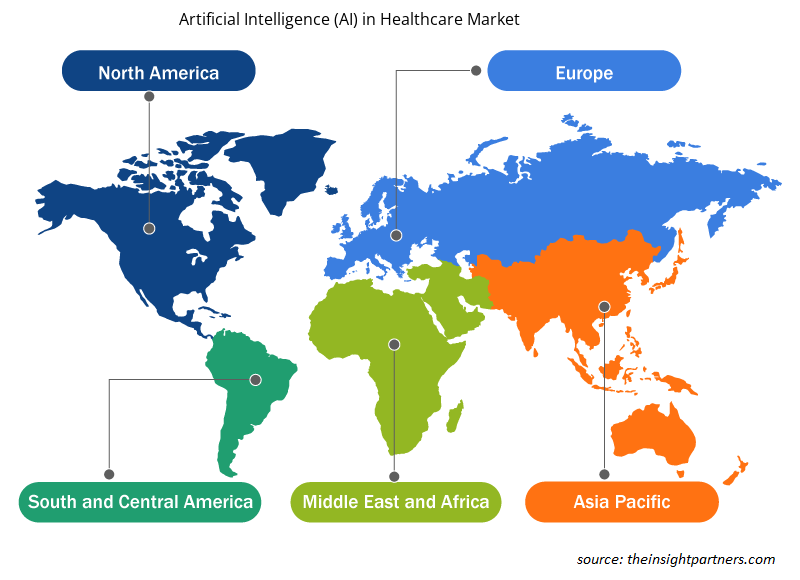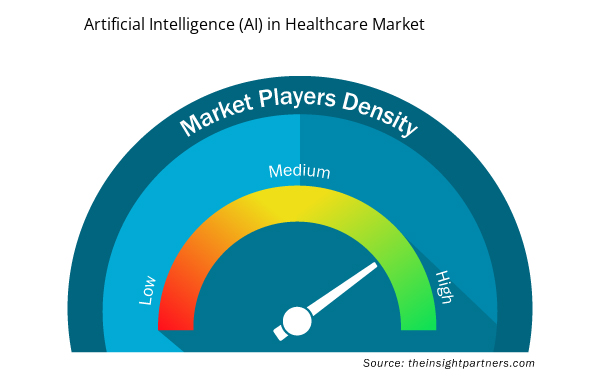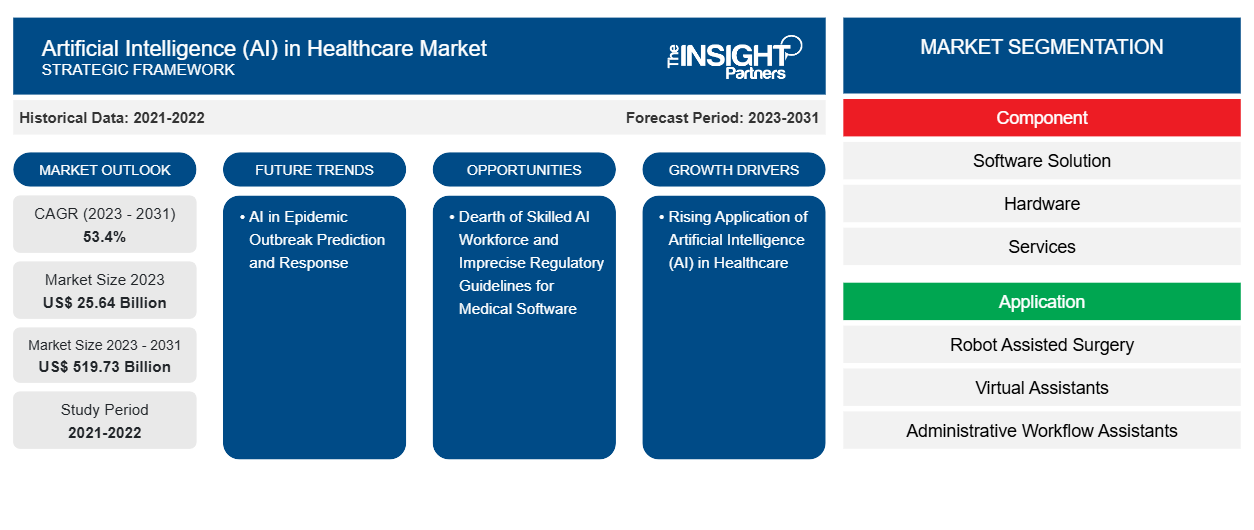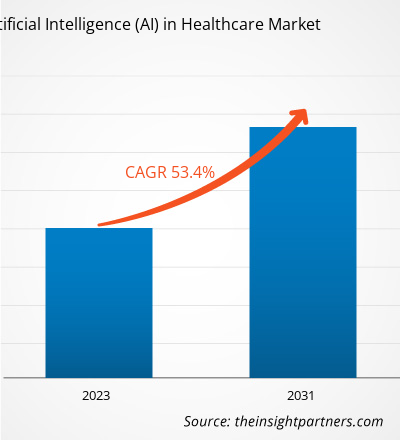ヘルスケアにおける人工知能(AI)の市場規模は、2023年の256億4,000万米ドルから2031年には5,197億3,000万米ドルに達すると予測されています。市場は2023年から2031年の間に53.4%のCAGRを記録すると予想されています。
AI 搭載の自律型サービスロボット、ヒューマノイドロボット、リアルタイムの病気監視、拡散傾向の分析と視覚化、感染率と感染傾向の推定、効果的な治療法を特定するための迅速な意思決定の開発は、予測期間中、ヘルスケア市場における人工知能 (AI) の主要なトレンドであり続けると思われます。
ヘルスケア市場分析における人工知能 (AI)
大規模で複雑な医療データセットの流入の増加は、医療市場における人工知能(AI)の推進力となっています。さらに、ハードウェアコストを最小限に抑えることで、医療費の削減とコンピューティングパワーの向上を同時に実現する必要性が高まっています。さらに、医療におけるAIの実装を促進するための政府の取り組みと協力の拡大、市場プレーヤーによる合併や買収、ポートフォリオの拡大によって市場が活性化しています。医療従事者と患者の間には不均衡があります。人工知能はこのバランスを回復し、医療市場における人工知能(AI)の成長を牽引します。精密医療と臨床試験プロセスの使用が増えるとAIが必要になり、市場がさらに推進されます。この分野の研究開発への資金提供の増加は、医療市場における人工知能(AI)の成長に貢献しています。
ヘルスケア市場における人工知能 (AI) の概要
AI は医療のさまざまな分野で応用されています。医師は AI によって情報を取得し、スキャン中に撮影された画像を解釈し、治療計画を立てることができます。臨床面に加えて、AI は研究活動にも役立ちます。公衆衛生、イノベーション、研究、テクノロジーの進歩に支えられた医学の進歩により、罹患率と死亡率が大幅に低下しています。医療分野は、AI を活用して生産性を高め、医療従事者の膨大な負担を軽減することで、大きく進化しています。政府機関や民間組織は、開発を加速するために AI を研究活動に取り入れています。
要件に合わせてレポートをカスタマイズする
このレポートの一部、国レベルの分析、Excelデータパックなど、あらゆるレポートを無料でカスタマイズできます。また、スタートアップや大学向けのお得なオファーや割引もご利用いただけます。
- このレポートの主要な市場動向を入手してください。この無料サンプルには、市場動向から見積もりや予測に至るまでのデータ分析が含まれます。
ヘルスケア市場の推進要因と機会における人工知能 (AI)
業界間のパートナーシップとコラボレーションの拡大
業界間のパートナーシップにより、リスクを予測し、認知支援を提供する新しい機械学習 (ML) モデルが導入されています。このパートナーシップは、公共、民間、非営利などのさまざまなセクターをつなぐ企業と社会の関係において、最もダイナミックな実践の 1 つです。2023 年 10 月、シーメンスとマイクロソフトは、業界全体で AI の導入を推進するために提携しました。両社は、製造業における人間と機械のコラボレーションを改善するために共同開発された AI 搭載アシスタントである Siemens Industrial Copilot を導入しています。さらに、Siemens Teamcenter 製品ライフサイクル管理ソフトウェアと Microsoft Teams の統合により、産業メタバースのさらなる開発への道が開かれます。2023 年 1 月、アストラゼネカは、放射線画像を解釈するためのディープラーニング アルゴリズムの開発者である Qure.ai と協力しました。このコラボレーションは、特に低所得国と中所得国で、診断ツールへのアクセスを制限する障壁を克服し、肺がんの早期発見をサポートし、死亡率を下げ、患者の転帰を改善することに特に焦点を当てます。
新興国経済の潜在力の高まり
医療技術、医療専門家、およびリソースへのアクセスが限られている発展途上国では、AI アプリケーションの影響が、現在の大きな課題を解決するための破壊的な道筋を提供する可能性があります。たとえば、デリーのインド工科大学 (IIT) の研究者は、胸部 X 線を使用して結核 (TB) を診断する AI 搭載システムを開発しました。このシステムは、X 線画像を 1 分未満で分析して結核の兆候を検出できるため、医療専門家へのアクセスが限られている可能性のある遠隔地での結核診断に役立つツールになります。ブラジルでは、大都市の郊外でさえ、ほとんどの都市で皮膚科医が不足しています。一流病院は、AI スクリーニング ツールを搭載した遠隔皮膚科サービスを提供することで、アクセスのギャップを縮小しています。さらに、AI 技術の使用により、医療費が削減され、発展途上国の人々が手頃な価格で医療を受けられるようになります。
ヘルスケア市場レポートにおける人工知能(AI)のセグメンテーション分析
ヘルスケア市場分析における人工知能 (AI) の導出に貢献した主要なセグメントは、コンポーネント、アプリケーション、エンドユーザーです。
- コンポーネントに基づいて、ヘルスケア市場における人工知能 (AI) は、ソフトウェア ソリューション、ハードウェア、およびサービスに分類されます。ソフトウェア ソリューション セグメントは、2023 年に最大の市場シェアを占めました。
- アプリケーション別に見ると、市場はロボット支援手術、仮想アシスタント、管理ワークフローアシスタント、コネクテッドマシン、診断、臨床試験、不正検出、サイバーセキュリティ、投薬ミス削減などに分かれています。ロボット支援手術セグメントは、2023年に市場で最大のシェアを占めました。cybersecurity, dosage error reduction, and others. The robot-assisted surgery segment held the largest share of the market in 2023.
- エンドユーザーの観点から見ると、市場は病院および医療提供者、患者、製薬およびバイオテクノロジー企業、医療保険者、その他に分類されます。病院および医療提供者セグメントは、2023年に市場を支配しました。pharma & biotech companies, healthcare payers, and others. The hospitals & healthcare providers segment dominated the market in 2023.
ヘルスケアにおける人工知能 (AI) の地域別市場シェア分析
ヘルスケア市場レポートにおける人工知能 (AI) の地理的範囲は、主に北米、アジア太平洋、ヨーロッパ、中東およびアフリカ、南米および中米の 5 つの地域に分かれています。
ヘルスケアにおける人工知能(AI)市場は北米が優勢でした。北米の市場成長は、ヘルスケアにおけるデジタルインフラの進化、確立されたヘルスケア部門、AIの利点に関する患者の意識の高まりに起因しています。北米のヘルスケアにおける人工知能(AI)市場は、市場にさまざまな主要プレーヤーが存在することでも刺激を受ける可能性があります。さらに、品質の向上とコスト削減のためにヘルスケア業務にデジタルツールが導入されていることも、ヘルスケアにおける人工知能(AI)市場における北米の優位性に貢献しています。今後数年間、アジア太平洋地域は最高のCAGRを記録すると予想されています。CAGR in the coming years.
ヘルスケア市場における人工知能 (AI) の地域別洞察
予測期間を通じてヘルスケア市場における人工知能 (AI) に影響を与える地域的な傾向と要因は、Insight Partners のアナリストによって徹底的に説明されています。このセクションでは、ヘルスケア市場における人工知能 (AI) のセグメントと、北米、ヨーロッパ、アジア太平洋、中東、アフリカ、南米、中米の地域についても説明します。

- ヘルスケア市場における人工知能(AI)の地域別データを入手
ヘルスケア市場における人工知能(AI)レポートの範囲
| レポート属性 | 詳細 |
|---|---|
| 2023年の市場規模 | 256.4億米ドル |
| 2031年までの市場規模 | 5,197.3億米ドル |
| 世界のCAGR(2023年~2031年) | 53.4% |
| 履歴データ | 2021-2022 |
| 予測期間 | 2023-2031 |
| 対象セグメント | コンポーネント別
|
| 対象地域と国 | 北米
|
| 市場リーダーと主要企業プロフィール |
|
ヘルスケア市場における人工知能 (AI) のプレーヤー密度: ビジネスダイナミクスへの影響を理解する
ヘルスケア市場における人工知能 (AI) は、消費者の嗜好の変化、技術の進歩、製品の利点に対する認識の高まりなどの要因により、エンドユーザーの需要が高まり、急速に成長しています。需要が高まるにつれて、企業は提供内容を拡大し、消費者のニーズを満たすために革新を起こし、新たなトレンドを活用し、市場の成長をさらに促進しています。
市場プレーヤー密度とは、特定の市場または業界内で活動している企業または会社の分布を指します。これは、特定の市場スペースに、その規模または総市場価値と比較して、どれだけの競合相手 (市場プレーヤー) が存在するかを示します。
ヘルスケア市場における人工知能 (AI) で事業を展開している主要企業は次のとおりです。
- NVIDIA コーポレーション、
- ニュアンスコミュニケーションズ株式会社
- マイクロソフト、
- ゼネラル・エレクトリック・カンパニー、
- インテルコーポレーション、
- アルファベット社、
免責事項:上記の企業は、特定の順序でランク付けされていません。

- ヘルスケア市場における人工知能(AI)の主要プレーヤーの概要を入手
ヘルスケア市場における人工知能(AI)のニュースと最近の動向
ヘルスケア市場における人工知能 (AI) は、企業の出版物、協会データ、データベースなどの一次調査と二次調査後の定性的および定量的データを収集することによって評価されます。ヘルスケア市場における人工知能 (AI) の開発のいくつかを以下に示します。
- バイエルと Google Cloud は、放射線科医をサポートし、最終的には患者へのサービス向上を図る AI ソリューションの開発で提携することを発表しました。この提携の一環として、バイエルは、生成 AI (gen AI) ツールを含む Google Cloud のテクノロジーを使用して、放射線科に明確に焦点を当てた AI 搭載ヘルスケア アプリケーションの開発と導入を加速するためのイノベーション プラットフォームを開発します。この提携の目的は、組織が最先端のデータ セキュリティ機能を使用して、スケーラブルでコンプライアンスに準拠した AI 搭載医療用画像ソフトウェア製品を構築する際の多くの課題を克服し、最終的に患者に利益をもたらす可能性のある画期的で影響力のあるソリューションの開発を加速できるようにすることです。(出典: Google Cloud、プレス リリース、2024 年)
- OM1 は、AI を活用したパーソナライズ医療プラットフォームである PhenOM を立ち上げました。OM1 の長期的健康履歴データセットを使用して調整された PhenOM は、AI を使用して、病状や結果に関連する固有のデジタル表現型を識別し、患者の記録を比較してリスクと機会を浮き彫りにします。PhenOM は、ライフサイエンス研究からポイントオブケアの臨床意思決定まで、ヘルスケアエコシステム全体にわたってパーソナライズされたヘルスケアの洞察を大規模に提供します。(出典: OM1、プレスリリース、2023 年)
- AI の急速な進歩と、健康と医療における AI の責任ある使用を定義する緊急の必要性に応えて、スタンフォード メディシンとスタンフォード人間中心人工知能研究所 (HAI) は、RAISE-Health (安全で公平な健康のための責任ある AI) の立ち上げを発表しました。この先駆的な取り組みは、AI イノベーションを取り巻く重要な倫理的および安全性の問題に対処し、この複雑で進化する分野を他の人々が乗り越えられるよう支援することを目指しています。(出典: スタンフォード メディシン、ニュースレター、2023 年)
- Google Cloud は、製薬会社、バイオテクノロジー企業、公共部門の組織向けに、新薬の発見と精密医療を促進する 2 つの新しい AI 搭載ライフサイエンス ソリューションを発表しました。世界中で利用可能な Target and Lead Identification Suite は、研究者がタンパク質の構造を予測し、アミノ酸の機能を特定するのに役立ちます。また、Multiomics Suite は、ゲノム データの発見と解釈を加速し、企業が精密治療を設計するのに役立ちます。(出典: Google Cloud、プレス リリース、2023 年)
ヘルスケア市場における人工知能 (AI) レポートの対象範囲と成果物
「ヘルスケアにおける人工知能(AI)の市場規模と予測(2021〜2031年)」レポートでは、以下の分野をカバーする市場の詳細な分析を提供しています。
- 調査対象範囲に含まれるすべての主要市場セグメントについて、ヘルスケア市場における人工知能(AI)の規模と世界、地域、国レベルでの予測
- ヘルスケア市場における人工知能(AI)の動向、推進要因、制約、主要な機会などの市場動向
- 詳細なPEST/ポーターの5つの力とSWOT分析
- ヘルスケア市場における人工知能(AI)分析では、主要な市場動向、世界および地域の枠組み、主要プレーヤー、規制、最近の市場動向を取り上げています。
- ヘルスケア市場における人工知能(AI)の市場集中、ヒートマップ分析、主要プレーヤー、最近の動向を網羅した業界展望と競争分析
- 詳細な企業プロフィール
- 過去2年間の分析、基準年、CAGRによる予測(7年間)
- PEST分析とSWOT分析
- 市場規模価値/数量 - 世界、地域、国
- 業界と競争環境
- Excel データセット


- Personality Assessment Solution Market
- Arterial Blood Gas Kits Market
- Toothpaste Market
- Authentication and Brand Protection Market
- Data Center Cooling Market
- Artificial Intelligence in Healthcare Diagnosis Market
- Intraoperative Neuromonitoring Market
- Batter and Breader Premixes Market
- Adaptive Traffic Control System Market
- Fertilizer Additives Market

Report Coverage
Revenue forecast, Company Analysis, Industry landscape, Growth factors, and Trends

Segment Covered
This text is related
to segments covered.

Regional Scope
North America, Europe, Asia Pacific, Middle East & Africa, South & Central America

Country Scope
This text is related
to country scope.
Trends and growth analysis reports related to Technology, Media and Telecommunications : READ MORE..
The Insight Partners performs research in 4 major stages: Data Collection & Secondary Research, Primary Research, Data Analysis and Data Triangulation & Final Review.
- Data Collection and Secondary Research:
As a market research and consulting firm operating from a decade, we have published and advised several client across the globe. First step for any study will start with an assessment of currently available data and insights from existing reports. Further, historical and current market information is collected from Investor Presentations, Annual Reports, SEC Filings, etc., and other information related to company’s performance and market positioning are gathered from Paid Databases (Factiva, Hoovers, and Reuters) and various other publications available in public domain.
Several associations trade associates, technical forums, institutes, societies and organization are accessed to gain technical as well as market related insights through their publications such as research papers, blogs and press releases related to the studies are referred to get cues about the market. Further, white papers, journals, magazines, and other news articles published in last 3 years are scrutinized and analyzed to understand the current market trends.
- Primary Research:
The primarily interview analysis comprise of data obtained from industry participants interview and answers to survey questions gathered by in-house primary team.
For primary research, interviews are conducted with industry experts/CEOs/Marketing Managers/VPs/Subject Matter Experts from both demand and supply side to get a 360-degree view of the market. The primary team conducts several interviews based on the complexity of the markets to understand the various market trends and dynamics which makes research more credible and precise.
A typical research interview fulfils the following functions:
- Provides first-hand information on the market size, market trends, growth trends, competitive landscape, and outlook
- Validates and strengthens in-house secondary research findings
- Develops the analysis team’s expertise and market understanding
Primary research involves email interactions and telephone interviews for each market, category, segment, and sub-segment across geographies. The participants who typically take part in such a process include, but are not limited to:
- Industry participants: VPs, business development managers, market intelligence managers and national sales managers
- Outside experts: Valuation experts, research analysts and key opinion leaders specializing in the electronics and semiconductor industry.
Below is the breakup of our primary respondents by company, designation, and region:

Once we receive the confirmation from primary research sources or primary respondents, we finalize the base year market estimation and forecast the data as per the macroeconomic and microeconomic factors assessed during data collection.
- Data Analysis:
Once data is validated through both secondary as well as primary respondents, we finalize the market estimations by hypothesis formulation and factor analysis at regional and country level.
- Macro-Economic Factor Analysis:
We analyse macroeconomic indicators such the gross domestic product (GDP), increase in the demand for goods and services across industries, technological advancement, regional economic growth, governmental policies, the influence of COVID-19, PEST analysis, and other aspects. This analysis aids in setting benchmarks for various nations/regions and approximating market splits. Additionally, the general trend of the aforementioned components aid in determining the market's development possibilities.
- Country Level Data:
Various factors that are especially aligned to the country are taken into account to determine the market size for a certain area and country, including the presence of vendors, such as headquarters and offices, the country's GDP, demand patterns, and industry growth. To comprehend the market dynamics for the nation, a number of growth variables, inhibitors, application areas, and current market trends are researched. The aforementioned elements aid in determining the country's overall market's growth potential.
- Company Profile:
The “Table of Contents” is formulated by listing and analyzing more than 25 - 30 companies operating in the market ecosystem across geographies. However, we profile only 10 companies as a standard practice in our syndicate reports. These 10 companies comprise leading, emerging, and regional players. Nonetheless, our analysis is not restricted to the 10 listed companies, we also analyze other companies present in the market to develop a holistic view and understand the prevailing trends. The “Company Profiles” section in the report covers key facts, business description, products & services, financial information, SWOT analysis, and key developments. The financial information presented is extracted from the annual reports and official documents of the publicly listed companies. Upon collecting the information for the sections of respective companies, we verify them via various primary sources and then compile the data in respective company profiles. The company level information helps us in deriving the base number as well as in forecasting the market size.
- Developing Base Number:
Aggregation of sales statistics (2020-2022) and macro-economic factor, and other secondary and primary research insights are utilized to arrive at base number and related market shares for 2022. The data gaps are identified in this step and relevant market data is analyzed, collected from paid primary interviews or databases. On finalizing the base year market size, forecasts are developed on the basis of macro-economic, industry and market growth factors and company level analysis.
- Data Triangulation and Final Review:
The market findings and base year market size calculations are validated from supply as well as demand side. Demand side validations are based on macro-economic factor analysis and benchmarks for respective regions and countries. In case of supply side validations, revenues of major companies are estimated (in case not available) based on industry benchmark, approximate number of employees, product portfolio, and primary interviews revenues are gathered. Further revenue from target product/service segment is assessed to avoid overshooting of market statistics. In case of heavy deviations between supply and demand side values, all thes steps are repeated to achieve synchronization.
We follow an iterative model, wherein we share our research findings with Subject Matter Experts (SME’s) and Key Opinion Leaders (KOLs) until consensus view of the market is not formulated – this model negates any drastic deviation in the opinions of experts. Only validated and universally acceptable research findings are quoted in our reports.
We have important check points that we use to validate our research findings – which we call – data triangulation, where we validate the information, we generate from secondary sources with primary interviews and then we re-validate with our internal data bases and Subject matter experts. This comprehensive model enables us to deliver high quality, reliable data in shortest possible time.


 このレポートの無料サンプルを入手する
このレポートの無料サンプルを入手する